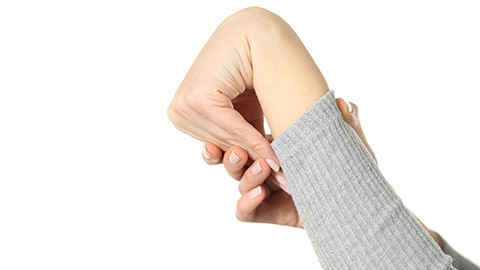
I’ve seen several requests for guidance about working with clients who have Ehlers-Danlos syndrome (EDS) lately. This genetic connective tissue disease creates symptoms that look like ordinary musculoskeletal injuries, but they’re not—this is why some doctors call people with EDS their “zebra patients”—as in, these hoofbeats are zebras, not horses.
For this episode I didn’t have a single contributor with a specific client, so I created a fictional person with EDS who would like to receive massage for back and neck pain, and headaches. I present the most important variables, and then we go through a critical thinking process to help set up some clinical decisions.
Will massage therapy fix EDS? No. Can it help? Absolutely yes. Listen on for more.
Resources: 
Case Report: Cornelia de Lange and Ehlers-Danlos: comorbidity of two rare syndromes (no date). Available at: https://www.ncbi.nlm.nih.gov/pmc/articles/PMC4746515/
Ehlers Danlos Syndromes - NORD (National Organization for Rare Disorders) (no date). Available at: https://rarediseases.org/rare-diseases/ehlers-danlos-syndrome/
Ehlers-Danlos Syndrome: Background, Pathophysiology, Etiology (no date). Available at: https://emedicine.medscape.com/article/1114004-overview
It’s Not About ‘Flexibility’ (no date) Murray Meetze. Available at: https://murraymeetze.com/uniquelystriped/its-not-about-flexibility
June 25, rew D.U. and 2018 (2018) ‘So-called Cirque du Soleil disease afflicts the extremely flexible | Ottawa Citizen’, 25 June. Available at: https://ottawacitizen.com/news/local-news/cirque-du-soeil-disease-afflicts-the-extremely-flexible
Kofton, S.L., Katryna (2019) What It’s Like to Have a Body That’s Literally Falling Apart, The Cut. Available at: https://www.thecut.com/2019/01/what-its-like-to-have-ehlers-danlos-syndrome.html
Massage & Bodywork - NOVEMBER | DECEMBER 2019. Available at: http://www.massageandbodyworkdigital.com/i/1174218-november-december-2019/40?


This podcast sponsored by:
About Anatomy Trains:
Anatomy Trains is a global leader in online anatomy education and also provides in-classroom certification programs forstructuralintegration in the US, Canada, Australia, Europe, Japan, and China, as well as fresh-tissue cadaverdissectionlabs and weekend courses. The work of Anatomy Trains originated with founder Tom Myers, who mapped the human body into 13 myofascial meridians in his original book, currently in itsfourthedition and translated into 12 languages. The principles of Anatomy Trains are used by osteopaths,physicaltherapists,bodyworkers,massagetherapists,personaltrainers,yoga,Pilates,Gyrotonics,and other body-minded manual therapists and movement professionals. Anatomy Trains inspires these practitioners to work with holistic anatomy in treating system-wide patterns to provide improved client outcomes in terms of structure and function.
Website:anatomytrains.com
Email:info@anatomytrains.com
Facebook:facebook.com/AnatomyTrains
Instagram: instagram.com/anatomytrainsofficial
0:00:00.0 Speaker 1: Ruth Werner's best-selling book, A Massage Therapist's Guide to Pathology, is a highly-regarded, comprehensive resource that sets the standard for pathology Education. Written for massage therapy students and practitioners, this ground-breaking resource serves up a comprehensive review of the pathophysiology, signs, symptoms, and treatment of more than 500 diseases and disorders. Learn more at booksofdiscovery.com.
0:00:33.1 Speaker 2: Anatomy Trains is delighted to announce a brand new Dissection Livestream Specialty Class on September 18th; LumboPelvic Stability, a one-day layered dissection with Anatomy Trains author Tom Myers, and master dissector Todd Garcia. The early bird price of $150 is held until September 10th. After September 10th, the price is $250. Come see the body's actual core for yourself. This course will be provided over Zoom webinar with multiple camera views, live chat and Q&A. Visit anatomytrains.com to sign up.
0:01:15.4 Speaker 3: Hi, and welcome to, I Have a Client Who, pathology conversations with Ruth Werner. The podcast where I will discuss your real life stories about clients with conditions that are perplexing or confusing.
0:01:28.6 S3: I'm Ruth Werner, author of A Massage Therapist's Guide to Pathology, and I have spent decades studying, writing about, and teaching about where massage therapy intersects with diseases and conditions that might limit our clients' health. We almost always have something good to offer, even with our most challenged clients, but we need to figure out a way to do that safely, effectively, and within our scope of practice. And sometimes, as we have all learned, that is harder than it looks.
0:02:01.8 S3: For this episode of, I Have a Client Who, I'm not going to pull a direct quote from one specific contributor, rather I will use the same question I've seen come up in a variety of locations over the last several weeks, which is essentially this; "What are some good recommendations for working with clients who have Ehlers-Danlos syndrome?" Well, I could cut this really short by directing interested listeners to the article I wrote on Ehlers-Danlos syndrome in the November-December 2019 edition of Massage and Bodywork Magazine called, Ehlers-Danlos Syndrome; This Time It's Zebras, Not Horses. And of course, I will include a link to that article in our show notes. It's a pretty complete overview, and it has a bonus video that covers all the gazillion subtypes of Ehlers-Danlos syndrome as well.
0:02:54.3 S3: That's a bit of a moving target because this is a genetic disorder, and as we learn more about it, different ways of classifying the subtypes emerged to disrupt everything that we thought was correct before, because this is all part of the joys of iterative learning. Right? But since we're all here, I'm happy to take a few minutes to give you a thumbnail sketch of this disorder with some special emphasis on important variables that might inform your decision-making process. Have you ever heard the saying, "When you hear hoofbeats, think horses, not zebras?" People with Ehlers-Danlos syndrome are sometimes called medical zebras, because they often present with what looks like Common Garden Variety musculoskeletal aches and pains, but this turns out to be related to a whole body problem with a variety of genetic mutations that interfere with the formation of collagen.
0:03:48.7 S3: Ehlers-Danlos syndrome, or things that look like it, have been in the medical record for literally thousands of years, dating back to 400 BCE. Edvard Ehlers and Henri-Alexandre Danlos joined their observations and proposed to label this collection of connective tissue disorders in 1936. So you've heard me say already, this is a genetic disorder, it has to do with mutations in the genes that control the production of collagen. Exactly what goes wrong and how severe it is depends on the type and severity of the mutation, but what this also means is that this condition has no cure, it can only be treated by addressing the symptoms it creates, and helping affected people to find ways to live with this sometimes, I should say, often, challenging situation.
0:04:44.3 S3: The main symptom for most forms of Ehlers-Danlos syndrome is super-duper hyper-mobility in the joints. This isn't the freedom of movement we get with healthy stretchy muscles, this is too much movement related to LAX ligaments, loose joint capsules. People with EDS are prone to frequent dislocations, but here's the thing, their ligaments might be loose, but their bones, and their cartilage, and their muscles and their tendons, they can all still be injured. So every time their shoulder pops out of right relationship, the other tissues that should be supporting the glenohumeral joint, well, they get stretched and injured and scarred up. When people with EDS dislocated fingers, those joints get damaged too. Slipping and sliding in the facet joints of the spine, that's a recipe for spondylitis, and bone spurs, and pain. In short, people with Ehlers-Danlos syndrome are a set-up for various kinds of osteoarthritis. And the joints are not the only places that tissues get hyper-mobile, the skin of people with Ehlers-Danlos syndrome can be stretchy, but it's also often very delicate, it bruises and tears easily. And because their Collagen production is faulty, healing can be a long, slow, frustrating process.
0:06:08.5 S3: Weak Collagen also affects the integrity of certain organs, bones tend to be shorter than average patients, are prone to scoliosis. Hollow structures may not withstand internal pressure well, and that means that some forms of EDS can involve aneurysms as weakened blood vessels bulge or maybe even rupture, and intestinal perforations and rupture of the bladder or the uterus. Ehlers-Danlos syndrome can affect the strength and function of the heart. It can cause weak valves, so we have mitral valve prolapse and a risk of heart failure, and some other really serious complications, weak collagen can affect the gums, so gum disease and tooth loss is a risk, and lots of other tissues can be compromised as well.
0:06:54.5 S3: Are we getting the picture? A person with Ehlers-Danlos Syndrome has some special challenges that people without EDS just don't have to deal with. I have a quote from the wonderful person who contributed to my article in Massage and Bodywork, and her case of Ehlers-Danlos syndrome was really only moderate. She said, "I have super elastic skin, my face is stretchy, I live with chronic, totally random pain. I had endometriosis and abdominal surgeries which led to massive amounts of scar tissue in my abdomen, I have Reno syndrome, scoliosis migraines, I had lots of complications with pregnancy, I had an umbilical hernia, my pubis symphysis separated, my feet were so hyper-mobile that bearing weight caused me excruciating pain. Later, when I had a hysterectomy, my surgeon was amazed that I was able to have a baby at all given the state of my uterus." So this can be intense.
0:07:58.7 S3: Let's get back to the questions that prompted this episode. What are some good recommendations for working with clients who have Ehlers-Danlos syndrome? Well, when we put this through the old critical thinking machine, here's where we might land: First, what's the main challenge? In other words, what does this person who has EDS want to achieve with massage? What do they think that their massage therapists will be able to help them with? Well, we don't know, do we? Because we don't really have a specific client that we're trying to help, but for the sake of this conversation, let's say our client wants to have less back and neck pain and maybe some help with their headaches. Okay, the next question then is, what are the variables that will go into this clinical decision-making process? What are the possible risks and benefits? Well, a lot of this depends on what kind of Ehlers-Danlos syndrome the person has and how severe it is, and what they do to treat it.
0:08:58.5 S3: Another important variable is how much day-to-day activity do they tolerate? Do they use pain medications? Do they need any special adaptive equipment? How healthy is their skin? So for the purposes of this little discussion, let's say they don't have super saggy skin, but they do have really slow wound-healing, they were in a car accident six months ago, and they're still dealing with neck pain and headaches from that, and the pain, the back pain goes back just as far as they can remember. They don't like to use pain relievers, but they find that in order to sleep, they usually have to take some Ibuprofen at night. Okay, now where are we? We need to make sure we're on the right track with understanding this client's goals, and we need to see if we can find any useful information about massage therapy for Ehlers-Danlos syndrome. That Massage and Bodywork article is a good place to start. And that has a pretty good bibliography, so that we could take a deeper look if we want to. It wouldn't hurt to scan the titles at pubmed.gov just to see if there's anything interesting there.
0:10:02.5 S3: I'll do that for you. A quick search of Massage and Ehlers-Danlos Syndrome yields a whopping great three results, and only one of them is available free full-text, and it is profoundly unhelpful. It is called Cornelia de Lange and Ehlers-Danlos: A comorbidity of two rare syndromes. This is an interesting case report, but it's not really what we're looking for for application of massage therapy. Now, if we took some time to use some other search terms like manual therapy or some other ideas, that would probably yield some more results, but I'm gonna let you explore that on your own. So we'll use all the information we have gathered to create and execute a treatment plan. We may find that our client's muscles are extra tight because they have to stabilize the spine and their neck. We might be able to lessen some of that tone, but let's be aware that that tightness is serving a purpose. More to the point. We can help with some pain relief and some attentive listening, and some focus on the client's strength and well-being, and to wrap up our critical thinking exercise for this, the last thing we wanna be sure to do is to decide how we're going to track whether we are being helpful to our client or not, and again, that will depend on your client's goals and how they want to get closer to achieving them.
0:11:31.7 S3: The person I interviewed for that article in Massage and Bodywork is also a massage therapist, and she works with a lot of people who have EDS, and she says this about her work, "My goal is to not trigger the flight or fight response. That's completely counter-productive. There's a big emotional component to living with pain, and I feel like part of my job is to say, "I see you. You're not crazy. I know how painful it is. I know there are consequences to every movement." Will massage therapy fix Ehlers-Danlos Syndrome? Definitely not. We can't undo the genetic anomalies that contribute to abnormal collagen formation, we can't tighten loose ligaments, or strengthen weakened blood vessels. But here, as with all painful and chronic conditions, what we can do is put our focus on reducing pain, reducing stress, and increasing the client's sense of themselves as whole and healthy humans. It's such important work, and I'm glad to be doing it with you."
0:12:46.3 S3: Hey everybody, thanks for listening to, I Have a Client Who, pathology conversations with Ruth Werner. Remember, you can send me your, I Have a Client Who, stories to, ihaveaclientwho@abmp.com. That's, I have a client who, all one word, all lowercase, @abmp.com. I can't wait to see what you send me and I'll see you next time.